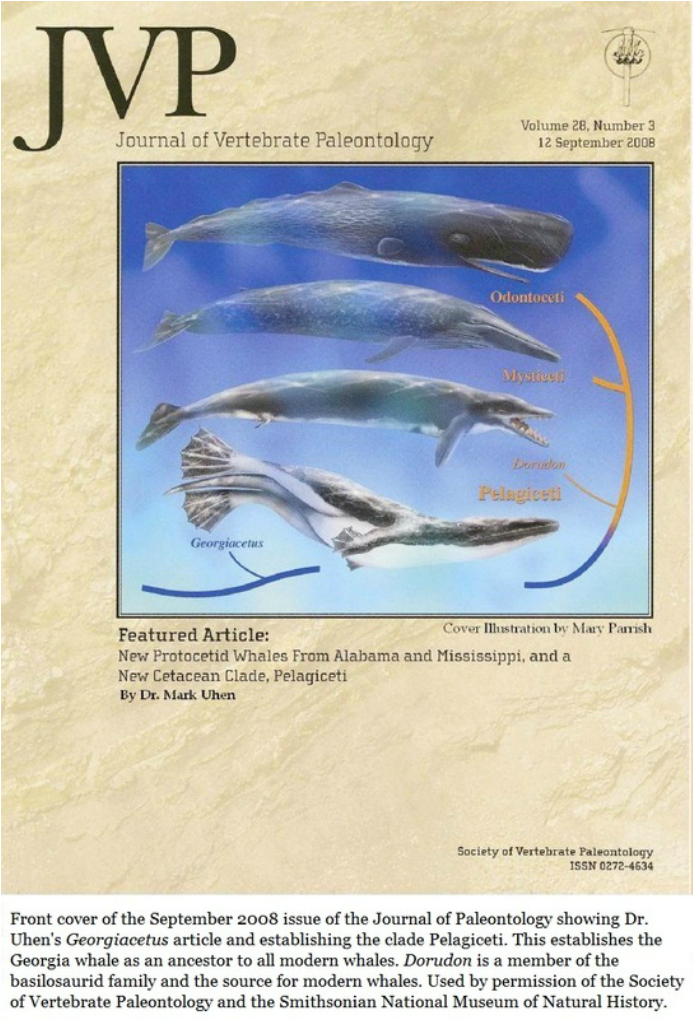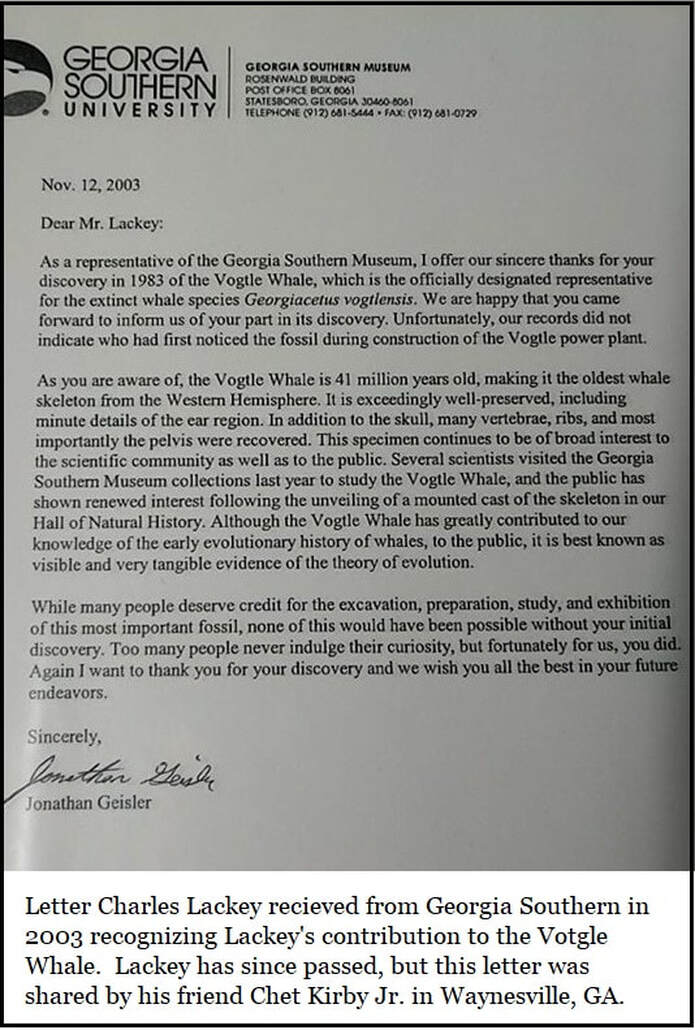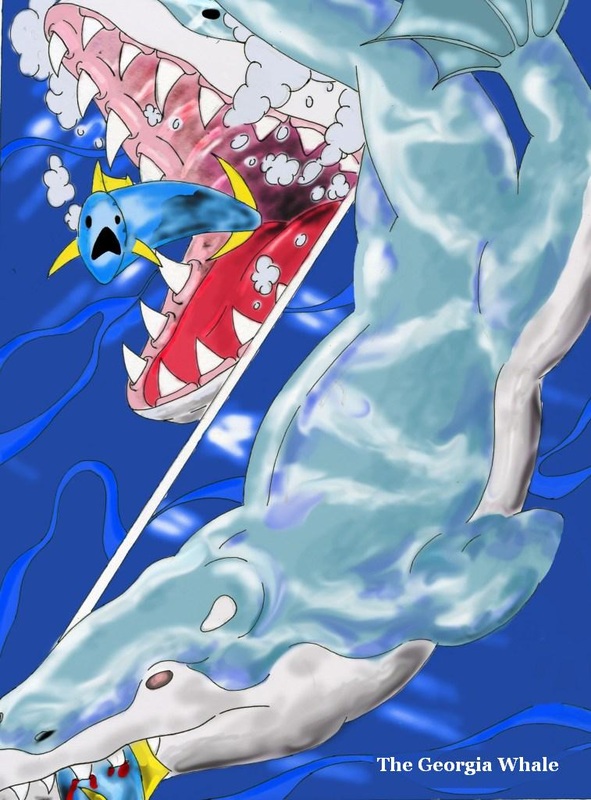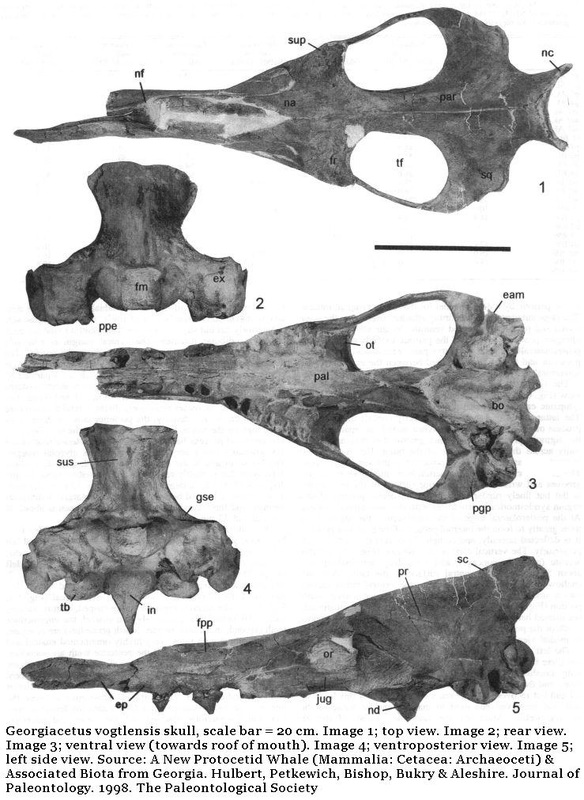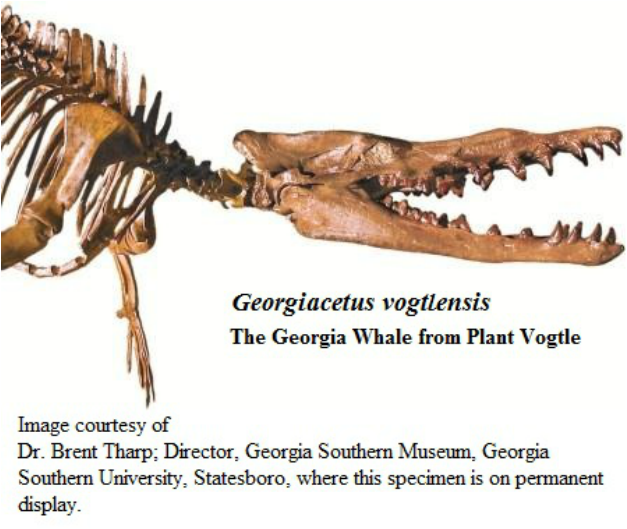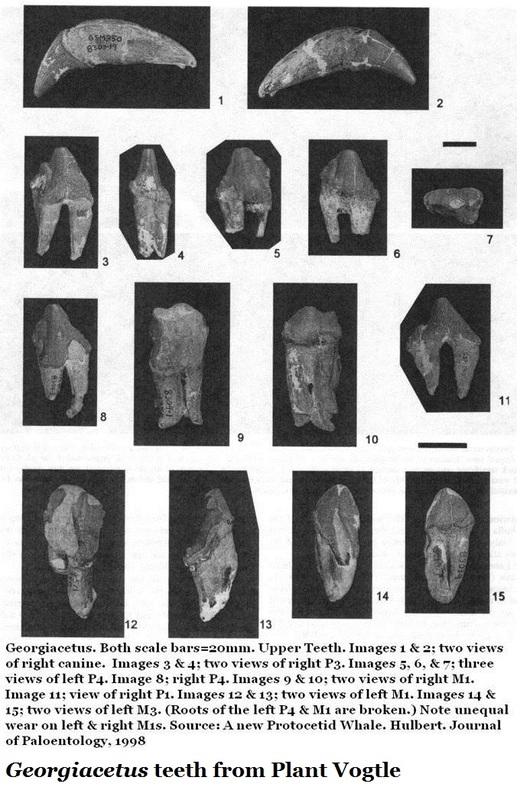11: A Whale for Georgia
Georgiacetus vogtlensis
One of Georgia's most important fossils.
By
Thomas Thurman
40.5 Million Years Ago
Georgiacetus vogtlensis
(The Georgia Whale; aka the Vogtle Whale)
Research suggests that the 40 million year old Georgia whale, a flukeless proto-whale, represents a turning point in the evolution of whales. Our Vogtle whale is a transition fossil in the natural history of whales. Dr. Mark Uhen of George Mason University is the lead researcher in the origins of modern whales. His work has traced their common ancestry through Georgiacetus vogtlensis.
The Georgia whale shows conclusively that evolution through natural selection operates randomly. The fossil disproves both creationism & intelligent design.
Bear in mind that the oldest stone tools are dated to 3.3 millions years ago and predate both our species, Homo sapiens sapiens, and our genus. Our species emerges into the fossil record at about 200,000 years ago. The modern whales were well established before we arrived.
Here is the story of how our Georgiacetus was discovered and what it tells us about whales.
Georgiacetus vogtlensis
(The Georgia Whale; aka the Vogtle Whale)
Research suggests that the 40 million year old Georgia whale, a flukeless proto-whale, represents a turning point in the evolution of whales. Our Vogtle whale is a transition fossil in the natural history of whales. Dr. Mark Uhen of George Mason University is the lead researcher in the origins of modern whales. His work has traced their common ancestry through Georgiacetus vogtlensis.
The Georgia whale shows conclusively that evolution through natural selection operates randomly. The fossil disproves both creationism & intelligent design.
Bear in mind that the oldest stone tools are dated to 3.3 millions years ago and predate both our species, Homo sapiens sapiens, and our genus. Our species emerges into the fossil record at about 200,000 years ago. The modern whales were well established before we arrived.
Here is the story of how our Georgiacetus was discovered and what it tells us about whales.
The Discovery of Georgiacetus
While cutting a drainage channel during the 1983 construction of Georgia Power’s Nuclear Power Plant Vogtle in Burke County, crews revealed a large mass of fossilized bones about 3o feet below the surface.
While cutting a drainage channel during the 1983 construction of Georgia Power’s Nuclear Power Plant Vogtle in Burke County, crews revealed a large mass of fossilized bones about 3o feet below the surface.
Charles R Lackey, an electrician with Georgia Power, first saw and reported something off in the ditch. Though he wasn't a paleontologist he did recognize that he was looking at the fossils of some prehistoric beast.
Lackey has since passed but his contribution to the Vogtle Whale story is remembered by GSU.
Lackey has since passed but his contribution to the Vogtle Whale story is remembered by GSU.
Thinking at first that they'd found some sort of alligator fossil, because of the snout and peg-like teeth, Georgia Power halted work and called in the Georgia Geologic Survey.
Geologist Earl A. Shapiro from the Survey responded and inspected the find. He recognized that this was no reptile, that it looked like a whale and the age of these sediments made it a potentially important find.
Shapiro called in Georgia Southern State University to excavate the 75% to 80% complete whale specimen. Dr. Richard Petkewich and Dr. Gale Bishop led the effort to recover the specimen and gather basic geological data.
Geologist Earl A. Shapiro from the Survey responded and inspected the find. He recognized that this was no reptile, that it looked like a whale and the age of these sediments made it a potentially important find.
Shapiro called in Georgia Southern State University to excavate the 75% to 80% complete whale specimen. Dr. Richard Petkewich and Dr. Gale Bishop led the effort to recover the specimen and gather basic geological data.
On a July 30, 2016 Dr. Gale Bishop from Georgia Southern University (retired) shared a Facebook post with Georgia's Fossils Group where he recalled the day he learned of the fossil from Shapiro and the specimen's recovery.
Earl Shapiro of the Georgia Geological Survey called me that eventful morning in May, 1983; “Bishop, they have discovered a fossil whale at Nuclear Plant Vogtle in Burke County. You guys ought to contact them and see if the specimen could be gifted to the Georgia Southern Museum. You'll be competing for the specimen with the Smithsonian Institution and Scripps Institute of Oceanography, keeping the specimen in Georgia is important.”
A quick phone call to Plant Vogtle and a quick afternoon visit to the Office of the Construction Superintendent, with co-conspirator and Vertebrate Paleontologist, Richard M. Petkewich, immediately followed.
The Superintendent asked, “How long will it take to get it out of our way?” Three days with Georgia Power construction support! Different strokes for different folks!
Eleven days later, we left Plant Vogtle with one of the most beautiful, most complete, best preserved fossil Eocene whales ever discovered in North America, safely jacketed in plaster and loaded on the back of a volunteered Vault Truck …. Win, Win, Win!
Between those days, an examination of the in situ fossil, eleven hard days exposing, trenching, jacketing, undercutting, and rolling casts; doing some PR for Plant Vogtle and GSU, with Frank Fortune photographing in the field, along with our documentation photography done on Kodachrome slide film.
Courtesy of Georgia Power, the site came with 24 hour security to protect the fossil, a small 2 x 4 rain shelter constructed to keep us working on rainy days, an air compressor and air hammer, with two experienced workers, and a backhoe for doing the heavy lifting.
With Dick Petkewich as Pit Boss the project went rapidly, at least as far as vertebrate fossil excavations go, with delineation of the skeleton, isolation into small blocks that could be handled easily (except for the humongous Skull Block, that weighed in at about 3100 pounds …. And, FINALLY, loading out at Plant Vogtle and a triumphant drive to the GSU Museum and off loading into the new GSU Museum. (Georgia Southern Museum)
This intense excavation saw many volunteer workers from GSU including Faculty; James Darrell, Richard Petkewich, David Quattlebaum, and myself (Gale Bishop) and great numbers of students (Brian K. Meyer & others).
Earl Shapiro of the Georgia Geological Survey called me that eventful morning in May, 1983; “Bishop, they have discovered a fossil whale at Nuclear Plant Vogtle in Burke County. You guys ought to contact them and see if the specimen could be gifted to the Georgia Southern Museum. You'll be competing for the specimen with the Smithsonian Institution and Scripps Institute of Oceanography, keeping the specimen in Georgia is important.”
A quick phone call to Plant Vogtle and a quick afternoon visit to the Office of the Construction Superintendent, with co-conspirator and Vertebrate Paleontologist, Richard M. Petkewich, immediately followed.
The Superintendent asked, “How long will it take to get it out of our way?” Three days with Georgia Power construction support! Different strokes for different folks!
Eleven days later, we left Plant Vogtle with one of the most beautiful, most complete, best preserved fossil Eocene whales ever discovered in North America, safely jacketed in plaster and loaded on the back of a volunteered Vault Truck …. Win, Win, Win!
Between those days, an examination of the in situ fossil, eleven hard days exposing, trenching, jacketing, undercutting, and rolling casts; doing some PR for Plant Vogtle and GSU, with Frank Fortune photographing in the field, along with our documentation photography done on Kodachrome slide film.
Courtesy of Georgia Power, the site came with 24 hour security to protect the fossil, a small 2 x 4 rain shelter constructed to keep us working on rainy days, an air compressor and air hammer, with two experienced workers, and a backhoe for doing the heavy lifting.
With Dick Petkewich as Pit Boss the project went rapidly, at least as far as vertebrate fossil excavations go, with delineation of the skeleton, isolation into small blocks that could be handled easily (except for the humongous Skull Block, that weighed in at about 3100 pounds …. And, FINALLY, loading out at Plant Vogtle and a triumphant drive to the GSU Museum and off loading into the new GSU Museum. (Georgia Southern Museum)
This intense excavation saw many volunteer workers from GSU including Faculty; James Darrell, Richard Petkewich, David Quattlebaum, and myself (Gale Bishop) and great numbers of students (Brian K. Meyer & others).
The Vogtle Whale was set up in a preparation booth in the Hall Of Natural History and used as a working exhibit, (early to mid 1980's?) before such exhibits were generally recognized.
Dick Petkewich and his Museum Students worked diligently for nearly a decade preparing the skeleton by carefully removing rock from around the bones. As Dick approached the final phase; preparation of the skull, he “froze” out of apprehension of destroying such a valuable specimen.
Richard Hulbert appeared as a new hire and finished off the project, preparing the exceptional skull, missing only its “snout,” which had been taken by construction workers when the fossil “alligator” was first exposed.
Eventually, many of these teeth and bone fragments returned to the Museum in an unofficial amnesty program; an early Paleontology form of “Don’t ask, Don’t tell.”
The Vogtle Whale was mounted in a diving pose in which we now see it in the Hall of Natural History.
Thanks Gale Bishop for the history!
Dick Petkewich and his Museum Students worked diligently for nearly a decade preparing the skeleton by carefully removing rock from around the bones. As Dick approached the final phase; preparation of the skull, he “froze” out of apprehension of destroying such a valuable specimen.
Richard Hulbert appeared as a new hire and finished off the project, preparing the exceptional skull, missing only its “snout,” which had been taken by construction workers when the fossil “alligator” was first exposed.
Eventually, many of these teeth and bone fragments returned to the Museum in an unofficial amnesty program; an early Paleontology form of “Don’t ask, Don’t tell.”
The Vogtle Whale was mounted in a diving pose in which we now see it in the Hall of Natural History.
Thanks Gale Bishop for the history!
Happily, you can visit Georgia Southern Museum today and see a reconstructed Georgiacetus on display along with several of the original fossils. Georgia Southern Museum's website: academics.georgiasouthern.edu/museum/
Dr. Richard Hulbert (currently with Florida Museum of Natural History; University of Florida) led the Georgia Southern team which described what proved to be an important new genus and species of early whale.
Like Indohyus, the distinctive ear bone structure clearly shows a relationship to modern whales.
During the original construction of Plant Vogtle fossils from two other individuals were also recovered and identified as members of the same species.
These additional fossils from other individual whales were recovered from other locations at the construction site, and at a different times.
The second animal was represented by a single forward vertebra.
The third animal was represented by three forward vertebrae, portions of at least four ribs, and the partial crown of a single tooth.
All of these fossils were found about 93 miles inland from the modern shoreline. The coastline these whales knew was further inland still, probably resting north of the Fall Line.
Dr. Richard Hulbert (currently with Florida Museum of Natural History; University of Florida) led the Georgia Southern team which described what proved to be an important new genus and species of early whale.
Like Indohyus, the distinctive ear bone structure clearly shows a relationship to modern whales.
During the original construction of Plant Vogtle fossils from two other individuals were also recovered and identified as members of the same species.
These additional fossils from other individual whales were recovered from other locations at the construction site, and at a different times.
The second animal was represented by a single forward vertebra.
The third animal was represented by three forward vertebrae, portions of at least four ribs, and the partial crown of a single tooth.
All of these fossils were found about 93 miles inland from the modern shoreline. The coastline these whales knew was further inland still, probably resting north of the Fall Line.
Named Georgiacetus vogtlensis (Meaning Georgia-whale from Plant Vogtle), these three early whales lived 40 million years ago and hunted the rich, Suwannee Current powered, coastal sea. This was during the earliest Bartonian Stage of the Eocene Epoch which ran from 40.5 to 37.2 million years ago.
The largest mass of bones, a partial fossilized skeleton, was recovered from an area about 3.3 meters (11ft) square and included about 60 separate bones and teeth belonging to an adult whale.
The largest mass of bones, a partial fossilized skeleton, was recovered from an area about 3.3 meters (11ft) square and included about 60 separate bones and teeth belonging to an adult whale.
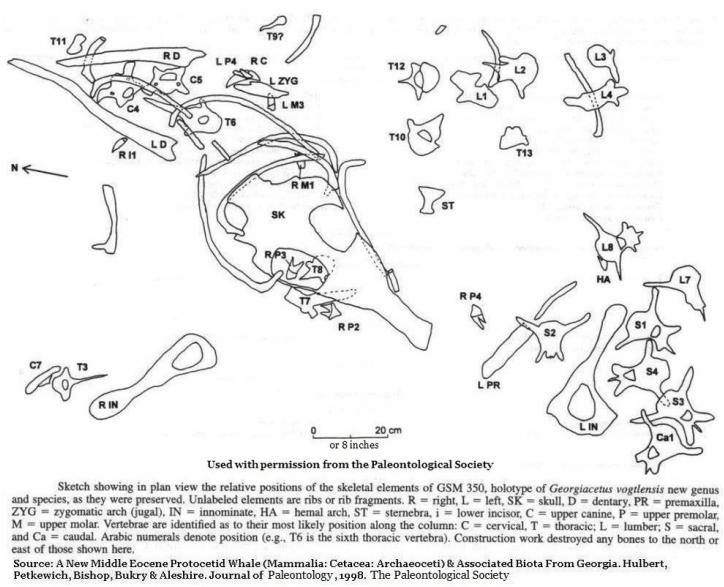
As mentioned, they were discovered as heavy equipment was cutting a drainage channel, so any material resting to the north or east of the main mass of bones was destroyed and it’s impossible to know how complete the original mass of bones might have been.
The individual showed fully erupted and well-worn adult teeth, so this was a mature animal. The clustering of bones suggests a single individual and there was no duplication of bones, further supporting that a single animal was represented.
The main mass of fossilized bones were not heavily mineralized and remained relatively light, porous and brittle. Some were cracked or crushed during burial and being compacted by the weight of the sediments, damage was greatest where bones rested atop one another. There was no apparent cause of death and animal had come to rest on the sea floor in a relatively shallow, but open shelf, off-shore location.
Invertebrate fossils including foraminifera, sea shells, found in relation to the skeleton and surrounding sediments all belong to animals known to occur in shallow, open water environments. Burial by sediments did not happen quickly as there was moderate growth of bryozoans and barnacles on the whale’s bones. These various invertebrate species were used to accurately date the whale fossils.
Though the remains of most of the animal were present, they were not articulated or in their natural positions, this is held as evidence of savaging. The hind legs and tail were missing; this may be a result of being carried away by scavengers or natural action by tides or currents.
Scavenging by sharks and other large vertebrates occurred, but only to a small degree. In many cases where fossils of large vertebrates have been recovered from open water resting places, large numbers of shark’s teeth (lost while feeding) are found near the fossils and the bones are damaged by feeding scratch marks.
With the main Georgiacetus skeleton fewer than 10 shark’s teeth were found and only one rib showed scratch marks.
Researchers concluded that most scavenging had been carried out by bacteria, invertebrates and small fish. In support of this, the area within 10 centimeters (4 inches) around the whale fossils contained a higher population of mollusks (gastropods and bivalves) than the surrounding areas.
Vertebrate fossils found in relation to the Georgiacetus fossil.
Scientific name Common Name
Carcharias macrota Sand/Tiger Shark
Carcharhinus macloti Hardnose Shark (Requiem family)
Triaenodon (Species unknown) Reef Shark
Myliobatidae (Species unknown) Eagle Ray (Shark family)
Cylindracanthus rectus small billfish (rare fossil)
The individual showed fully erupted and well-worn adult teeth, so this was a mature animal. The clustering of bones suggests a single individual and there was no duplication of bones, further supporting that a single animal was represented.
The main mass of fossilized bones were not heavily mineralized and remained relatively light, porous and brittle. Some were cracked or crushed during burial and being compacted by the weight of the sediments, damage was greatest where bones rested atop one another. There was no apparent cause of death and animal had come to rest on the sea floor in a relatively shallow, but open shelf, off-shore location.
Invertebrate fossils including foraminifera, sea shells, found in relation to the skeleton and surrounding sediments all belong to animals known to occur in shallow, open water environments. Burial by sediments did not happen quickly as there was moderate growth of bryozoans and barnacles on the whale’s bones. These various invertebrate species were used to accurately date the whale fossils.
Though the remains of most of the animal were present, they were not articulated or in their natural positions, this is held as evidence of savaging. The hind legs and tail were missing; this may be a result of being carried away by scavengers or natural action by tides or currents.
Scavenging by sharks and other large vertebrates occurred, but only to a small degree. In many cases where fossils of large vertebrates have been recovered from open water resting places, large numbers of shark’s teeth (lost while feeding) are found near the fossils and the bones are damaged by feeding scratch marks.
With the main Georgiacetus skeleton fewer than 10 shark’s teeth were found and only one rib showed scratch marks.
Researchers concluded that most scavenging had been carried out by bacteria, invertebrates and small fish. In support of this, the area within 10 centimeters (4 inches) around the whale fossils contained a higher population of mollusks (gastropods and bivalves) than the surrounding areas.
Vertebrate fossils found in relation to the Georgiacetus fossil.
Scientific name Common Name
Carcharias macrota Sand/Tiger Shark
Carcharhinus macloti Hardnose Shark (Requiem family)
Triaenodon (Species unknown) Reef Shark
Myliobatidae (Species unknown) Eagle Ray (Shark family)
Cylindracanthus rectus small billfish (rare fossil)
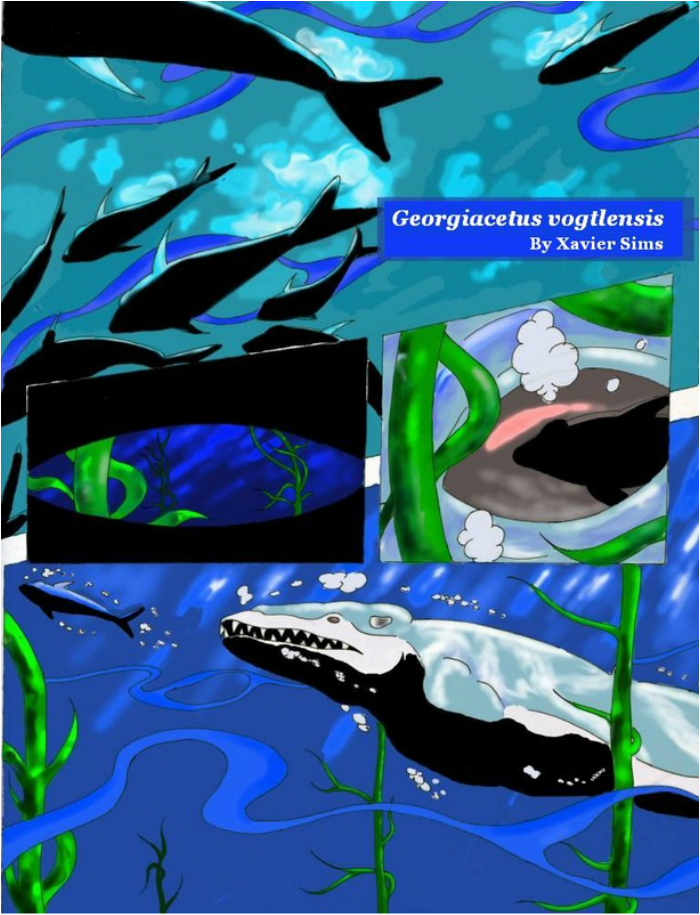
Though whales of this timeframe are well known from the Tethys Ocean up until this 1983 discovery there were only two North American reports of whale fossils from the Middle Eocene Epoch.
The first comes from 1938; Remington Kellogg, who served as the Director of the United States National Museum (now the Smithsonian National Museum of Natural History). He described a single whale vertebra from the Middle Eocene sediments in Texas.
Then in 1996, L. B. Albright described three teeth from Middle Eocene sediments of South Carolina, these teeth could easily have belonged to another Georgiacetus specimen.
Additionally; we’ll soon look at Georgiacetus specimens Dr. Mark Uhen recovered from Alabama and Mississippi; all of these reports taken together show that these whales were widespread in the Middle Eocene waters which once covered the Southeast.
Current research puts Georgiacetus as one of the last known links between the early proto-whales and modern whales, making this Georgia whale the most advanced of the known proto-whales and a scientifically important ancestor to all modern whales.
What is a proto-whale?
For our purposes we'll consider three basic "movements" (to borrow a musical term) in the evolution of whales.
Proto-whales; (formally; protoceti, ceti meaning whale.)
Our Georgiacetus occupies a unique position in whale evolution; it possesses features which make it one of the most advanced known protocetids and one of the most basal (basic & primitive) archaeocetids!
For our purposes we'll consider three basic "movements" (to borrow a musical term) in the evolution of whales.
Proto-whales; (formally; protoceti, ceti meaning whale.)
- Earliest whales transitioning to a marine environment.
- Essentially four functional limbs and a flukeless tail.
- Nostrils still at tip of snout
- Fully marine
- Fore limbs are flippers
- Hind legs atrophied and lacking bony attachment to spine.
- Nostril relocated to bridge of nose
- Flukes present(except for the earliest) and used as primary locomotion.
- Two groups
- baleen (formally; Mysticeti)
- toothed (formally; Ondontoceti)
- Hind legs absent (though greatly reduced pelvis is still present in the body)
- Blowhole present as adapted nostril(s) at top of head between eyes.
- Single blowhole in toothed whales
- Two blowholes for baleen whales.
Our Georgiacetus occupies a unique position in whale evolution; it possesses features which make it one of the most advanced known protocetids and one of the most basal (basic & primitive) archaeocetids!
Georgiacetus
This was a large animal. The skull is more than 30 inches long (76 cm), 12 inches wide (30.5 cm) and about 24 inches (61 cm) deep, fleshed out it would have been decidedly larger.
It’s hard to know the total length of the animal as no legs or tail vertebrae were found, researchers estimate a length of at 10 to 20 feet (3 to 6 mteres) considering the head would have been nearly a meter long for a living animal.
The excellent skull showed that the proto-whale’s two nostrils, or blow holes, where halfway back on the snout, an evolutionary transition towards modern whales that would be repeated in its ancestors for millions of years.
If we look back at Indohyus, we see that its nostrils were at the tip of its snout, as in all terrestrial animals. This is an adaptation to allow locating the direction of scents. Terrestrial animals sweep their nostrils side to side and up and down to locate the source odors.
The relocated nostrils of early whales like Georgiacetus offered them the benefit of easier breathing at the sea’s surface. Of course in modern whales the blowhole is on top of the head, between the eyes, as seen in modern right whales and dolphins along Georgia’s coast.
Interestingly, modern toothed whales breath through a single nostril, with the other adapted towards their melon and echolocation. There is no evidence that modern tooth whales retain a sense of smell.
Modern baleen whales retain two nostrils and apparently at least some directional sense of smell, how this sense is currently used is still a matter of debate.
We simply don't know what sense of smell Georgiacetus might have possessed.
Other aspects of the skull and vertebrae strongly link Georgiacetus to the basilosaurids which are well known from the Southeast a few million years after Georgiacetus became extinct. We’ll look at the basilosaurids in detail a little later.
This was a large animal. The skull is more than 30 inches long (76 cm), 12 inches wide (30.5 cm) and about 24 inches (61 cm) deep, fleshed out it would have been decidedly larger.
It’s hard to know the total length of the animal as no legs or tail vertebrae were found, researchers estimate a length of at 10 to 20 feet (3 to 6 mteres) considering the head would have been nearly a meter long for a living animal.
The excellent skull showed that the proto-whale’s two nostrils, or blow holes, where halfway back on the snout, an evolutionary transition towards modern whales that would be repeated in its ancestors for millions of years.
If we look back at Indohyus, we see that its nostrils were at the tip of its snout, as in all terrestrial animals. This is an adaptation to allow locating the direction of scents. Terrestrial animals sweep their nostrils side to side and up and down to locate the source odors.
The relocated nostrils of early whales like Georgiacetus offered them the benefit of easier breathing at the sea’s surface. Of course in modern whales the blowhole is on top of the head, between the eyes, as seen in modern right whales and dolphins along Georgia’s coast.
Interestingly, modern toothed whales breath through a single nostril, with the other adapted towards their melon and echolocation. There is no evidence that modern tooth whales retain a sense of smell.
Modern baleen whales retain two nostrils and apparently at least some directional sense of smell, how this sense is currently used is still a matter of debate.
We simply don't know what sense of smell Georgiacetus might have possessed.
Other aspects of the skull and vertebrae strongly link Georgiacetus to the basilosaurids which are well known from the Southeast a few million years after Georgiacetus became extinct. We’ll look at the basilosaurids in detail a little later.
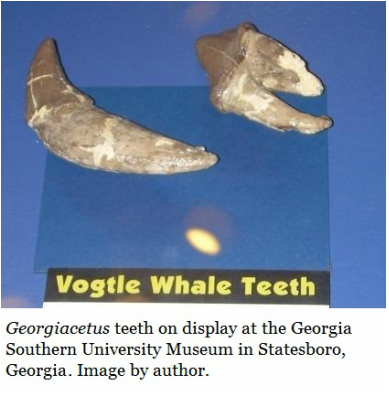
This link to later whales is especially true of the teeth; front teeth are adapted towards catching and holding prey. Center and rear teeth adapted towards dispatching, crushing and shearing prey into manageable portions (processing prey).
This closely resembles the basilosaurid tooth arrangement; one big difference is that Georgiacetus and the other proto-whales possessed three molars, the basilosaurids possessed two. Additionally; the triangular, twin rooted molars of the basilosaurids are prominently and heavily serrated.
This closely resembles the basilosaurid tooth arrangement; one big difference is that Georgiacetus and the other proto-whales possessed three molars, the basilosaurids possessed two. Additionally; the triangular, twin rooted molars of the basilosaurids are prominently and heavily serrated.

The teeth of older proto-whales possess the triangular shape and twin roots but lack serrations. The molars of Georgiacetus are triangular, twin rooted, and some show the beginnings of serrations.
A prominent crest on the Georgiacetus skull would have anchored powerful jaw muscles capable of dealing with larger prey. This combination of teeth and a crested skull anchoring large muscles suggests that Georgiacetus could easily process large fish into manageable chucks or bite through the shells of other animals.
A prominent crest on the Georgiacetus skull would have anchored powerful jaw muscles capable of dealing with larger prey. This combination of teeth and a crested skull anchoring large muscles suggests that Georgiacetus could easily process large fish into manageable chucks or bite through the shells of other animals.
Newly Discovered Georgiacetus Teeth
& A Fresh Review of the Blue Bluff Unit
Paleontologist Frank Willoughby did Coastal Plain mapping for the South Carolina Geological Survey from 1981 until his retirement in 2008.
In 2009 & 2010 he had the opportunity to review the sediments which produced Georgiacetus at the Vogtle Power plant expansion site.
In March 2011 he presented his findings at the 60th annual meeting of the Southeastern Section of the Geological Society of America.
gsa.confex.com/gsa/2011SE/finalprogram/abstract_184335.htm
Here is his abstract in it's entirety:
Excavations for Unit 3 and Unit 4 at Plant Vogtle, Burke County, Georgia exposed Eocene strata last seen here more than 20 years ago (Huddlestun and Hetrick, 1986). The base is in the upper 8 to 10 feet of the middle middle Eocene, informal Blue Bluff unit.
The lowest beds of Blue Bluff seen are hard, grayish green, fossiliferous, calcareous siltstone to quartz sandstone with the oyster Cubitostrea sellaeformis, two species of turritellids, other mollusks, and acorn and scalpelloid barnacles. Abundant tubular-conical cnidarian (scyphozoan?) polyps and fewer acorn barnacles coat pieces of a lignitic driftwood log from the Blue Bluff.
The uppermost 4 to 6 feet of the Blue Bluff are altered to white or light gray by waters percolated down from the partly karstic, informal Utley unit, which unconformably overlies the Blue Bluff at planar to contorted or burrowed (Glossifungites ichnofacies) contacts to 18 inches deep.
The Utley is white to pale tan, glauconitic, moldic, fossil-rich packstone to soft, brown or green, silt and clay residue and is up to 12 feet thick but is dissolved to absent locally.
The Utley unconformably underlies the calcareous Griffins Landing Member of the upper Eocene Dry Branch Formation with sharp to irregular contact. The Utley fauna includes a coral, a barnacle, and 15 molluscan species including Bathytormus protextus, Callista aequora, Glycymeris idonea, Linga pomilia alveata, Nucula magnifica, Doliocassis nupera, Neverita limula, and Ranellina maclurii, which correlate with the upper middle Eocene Gosport Sand in Alabama and the informal Orangeburg District bed in South Carolina. Other characteristic Gosport taxa include Athleta sayana, Levifusus trabeatus, and Crepidula lirata (Crepidula is not known from overlying Jackson or Vicksburg groups). Unconformable lower and upper contacts and the Gosport-equivalent molluscan fauna confirm the Utley as a depositional sequence separate from the Blue Bluff.
Hard, calcareous limestone with oyster Crassostrea gigantissima, other mollusks, acorn and scalpelloid barnacles, and other fossils is at the base of Griffins Landing Member and in bioherms in overlying quartz sand. Higher quartz sand without bioherms is Irwinton Sand Member of the Dry Branch Formation and underlies red, clayey quartzose, upper Eocene Tobacco Road Sand at a granule and pebble bed with minor disconformity.
New Georgiacetus Teeth
In a 5/August/2016 email Frank referred me to Dr. Katy Smith @ Georgia Southern Museum.
I spoke to Dr. Smith briefly after her presentation in March, 2016 and mentioned that two vertebrate teeth (which I now know are of Georgiacetus vogtlensis) were taken, by observant workers, from the excavations during the time when I had limited access to the recent excavations.
I prevailed on one generous worker to give me his whale tooth, on my promise to give the tooth to the Georgia Southern University Museum, and I did so.
I did not pester the other whale-tooth owner, but for the record at least two whale teeth were recovered from Plant Vogtle in 2009-2010. After I deposited the tooth at Georgia Southern, I looked up the original publication on Georgiacetus and realized that the two teeth I had seen were, of course, from Georgiacetus. So another tooth of Georgiacetus should reside at Statesboro. I’m hoping Dr. Smith will be able to locate the tooth I deposited at Georgia Southern.
Note from Thurman; I've emailed Dr. Smith at Georgia Southern but as of this writing there's been no reply. At this time it can't be known what position these teeth occupied in the living whale or if these finds represent additional individuals or additional material from a currently known individual.
& A Fresh Review of the Blue Bluff Unit
Paleontologist Frank Willoughby did Coastal Plain mapping for the South Carolina Geological Survey from 1981 until his retirement in 2008.
In 2009 & 2010 he had the opportunity to review the sediments which produced Georgiacetus at the Vogtle Power plant expansion site.
In March 2011 he presented his findings at the 60th annual meeting of the Southeastern Section of the Geological Society of America.
gsa.confex.com/gsa/2011SE/finalprogram/abstract_184335.htm
Here is his abstract in it's entirety:
Excavations for Unit 3 and Unit 4 at Plant Vogtle, Burke County, Georgia exposed Eocene strata last seen here more than 20 years ago (Huddlestun and Hetrick, 1986). The base is in the upper 8 to 10 feet of the middle middle Eocene, informal Blue Bluff unit.
The lowest beds of Blue Bluff seen are hard, grayish green, fossiliferous, calcareous siltstone to quartz sandstone with the oyster Cubitostrea sellaeformis, two species of turritellids, other mollusks, and acorn and scalpelloid barnacles. Abundant tubular-conical cnidarian (scyphozoan?) polyps and fewer acorn barnacles coat pieces of a lignitic driftwood log from the Blue Bluff.
The uppermost 4 to 6 feet of the Blue Bluff are altered to white or light gray by waters percolated down from the partly karstic, informal Utley unit, which unconformably overlies the Blue Bluff at planar to contorted or burrowed (Glossifungites ichnofacies) contacts to 18 inches deep.
The Utley is white to pale tan, glauconitic, moldic, fossil-rich packstone to soft, brown or green, silt and clay residue and is up to 12 feet thick but is dissolved to absent locally.
The Utley unconformably underlies the calcareous Griffins Landing Member of the upper Eocene Dry Branch Formation with sharp to irregular contact. The Utley fauna includes a coral, a barnacle, and 15 molluscan species including Bathytormus protextus, Callista aequora, Glycymeris idonea, Linga pomilia alveata, Nucula magnifica, Doliocassis nupera, Neverita limula, and Ranellina maclurii, which correlate with the upper middle Eocene Gosport Sand in Alabama and the informal Orangeburg District bed in South Carolina. Other characteristic Gosport taxa include Athleta sayana, Levifusus trabeatus, and Crepidula lirata (Crepidula is not known from overlying Jackson or Vicksburg groups). Unconformable lower and upper contacts and the Gosport-equivalent molluscan fauna confirm the Utley as a depositional sequence separate from the Blue Bluff.
Hard, calcareous limestone with oyster Crassostrea gigantissima, other mollusks, acorn and scalpelloid barnacles, and other fossils is at the base of Griffins Landing Member and in bioherms in overlying quartz sand. Higher quartz sand without bioherms is Irwinton Sand Member of the Dry Branch Formation and underlies red, clayey quartzose, upper Eocene Tobacco Road Sand at a granule and pebble bed with minor disconformity.
New Georgiacetus Teeth
In a 5/August/2016 email Frank referred me to Dr. Katy Smith @ Georgia Southern Museum.
I spoke to Dr. Smith briefly after her presentation in March, 2016 and mentioned that two vertebrate teeth (which I now know are of Georgiacetus vogtlensis) were taken, by observant workers, from the excavations during the time when I had limited access to the recent excavations.
I prevailed on one generous worker to give me his whale tooth, on my promise to give the tooth to the Georgia Southern University Museum, and I did so.
I did not pester the other whale-tooth owner, but for the record at least two whale teeth were recovered from Plant Vogtle in 2009-2010. After I deposited the tooth at Georgia Southern, I looked up the original publication on Georgiacetus and realized that the two teeth I had seen were, of course, from Georgiacetus. So another tooth of Georgiacetus should reside at Statesboro. I’m hoping Dr. Smith will be able to locate the tooth I deposited at Georgia Southern.
Note from Thurman; I've emailed Dr. Smith at Georgia Southern but as of this writing there's been no reply. At this time it can't be known what position these teeth occupied in the living whale or if these finds represent additional individuals or additional material from a currently known individual.
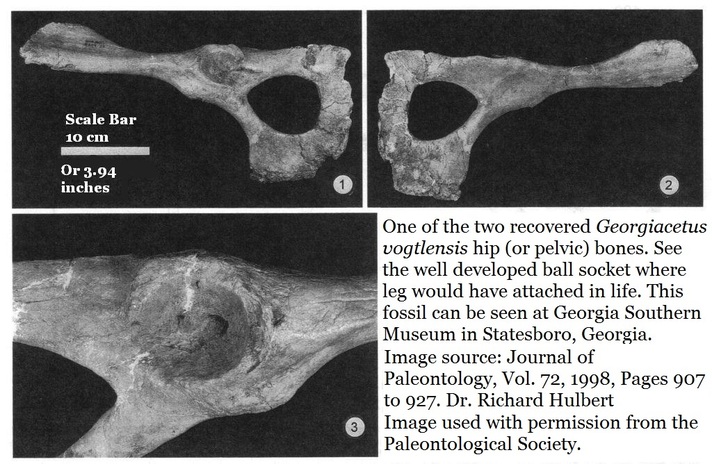
Evidence of Legs
The Vogtle Whale appears to have also had well-developed hind legs, though fossils from neither the legs nor tail were found. The pelvis (hip) bones were recovered and they show well developed ball sockets where the legs would have attached in life. This led researchers to question whether Georgiacetus swam with its hind legs and if it possessed a fluke.
Interestingly, the pelvis bones were not fused to the whale’s spine. These free floating pelvis bones meant that Georgiacetus could not support its own considerable weight on land and was likely fully marine. This is important as many of Georgiacetus’s ancestors were probably amphibious, living at sea but returning to land to give birth; much like modern seals or sea lions.
It may be that by the time Georgiacetus emerges into the fossil record whales had already left land behind forever, but the Plant Vogtle finds cannot fully answer this question; there just isn’t enough recovered material. So when whales transitioned to a fully marine life is still unknown.
Whales are the only predatory marine mammals to have accomplished this. The only other fully marine mammal is the siren, or manatee, family.
Modern whales also have free-floating pelvis bones but their's are tiny when compared to the well-developed hip bones of Georgiacetus.
For some years researcher’s strongly suspected that Georgiacetus possessed flukes, at least a primitive flukes, though there was no evidence either supporting or dismissing flukes.
The Vogtle Whale appears to have also had well-developed hind legs, though fossils from neither the legs nor tail were found. The pelvis (hip) bones were recovered and they show well developed ball sockets where the legs would have attached in life. This led researchers to question whether Georgiacetus swam with its hind legs and if it possessed a fluke.
Interestingly, the pelvis bones were not fused to the whale’s spine. These free floating pelvis bones meant that Georgiacetus could not support its own considerable weight on land and was likely fully marine. This is important as many of Georgiacetus’s ancestors were probably amphibious, living at sea but returning to land to give birth; much like modern seals or sea lions.
It may be that by the time Georgiacetus emerges into the fossil record whales had already left land behind forever, but the Plant Vogtle finds cannot fully answer this question; there just isn’t enough recovered material. So when whales transitioned to a fully marine life is still unknown.
Whales are the only predatory marine mammals to have accomplished this. The only other fully marine mammal is the siren, or manatee, family.
Modern whales also have free-floating pelvis bones but their's are tiny when compared to the well-developed hip bones of Georgiacetus.
For some years researcher’s strongly suspected that Georgiacetus possessed flukes, at least a primitive flukes, though there was no evidence either supporting or dismissing flukes.
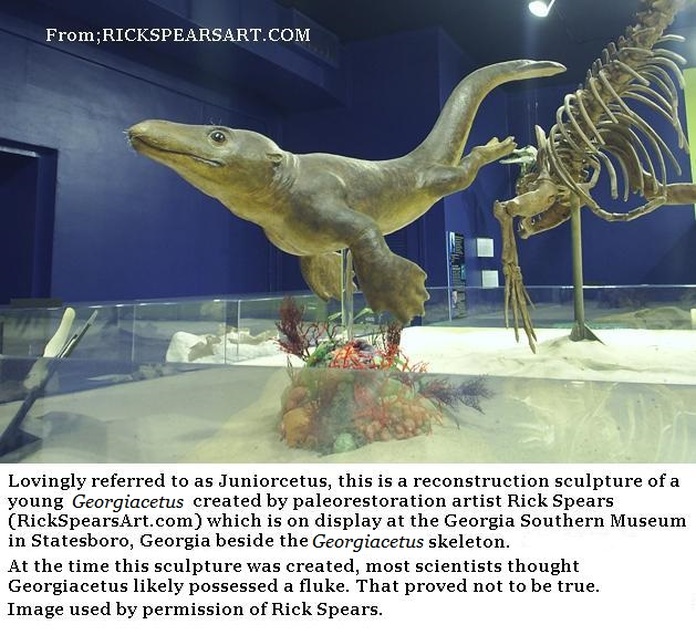
When visiting the Georgia Southern Museum, you’ll also see a fleshed out reconstruction of a juvenile Georgiacetus sculpture complete with flukes.
This sculpture was created by Rick Spears (www.rickspearsart.com/) and represents the “state of the science” before an important find was reported.
The Georgia whale has been illustrated several times, but even most modern illustrations show webbed front feet. Georgiacetus was descended from hoofed animals, most likely ‘’Indohyus’’.
Current opinion says that Georgiacetus likely didn’t have webbed front feet but fully encased front limbs as flippers, though these may well have been more like a seal’s front flippers than a modern whale’s. We have no front limb material to review so this is a guess, but with hoofed ancestors, webbed front feet seem unlikely.
This sculpture was created by Rick Spears (www.rickspearsart.com/) and represents the “state of the science” before an important find was reported.
The Georgia whale has been illustrated several times, but even most modern illustrations show webbed front feet. Georgiacetus was descended from hoofed animals, most likely ‘’Indohyus’’.
Current opinion says that Georgiacetus likely didn’t have webbed front feet but fully encased front limbs as flippers, though these may well have been more like a seal’s front flippers than a modern whale’s. We have no front limb material to review so this is a guess, but with hoofed ancestors, webbed front feet seem unlikely.
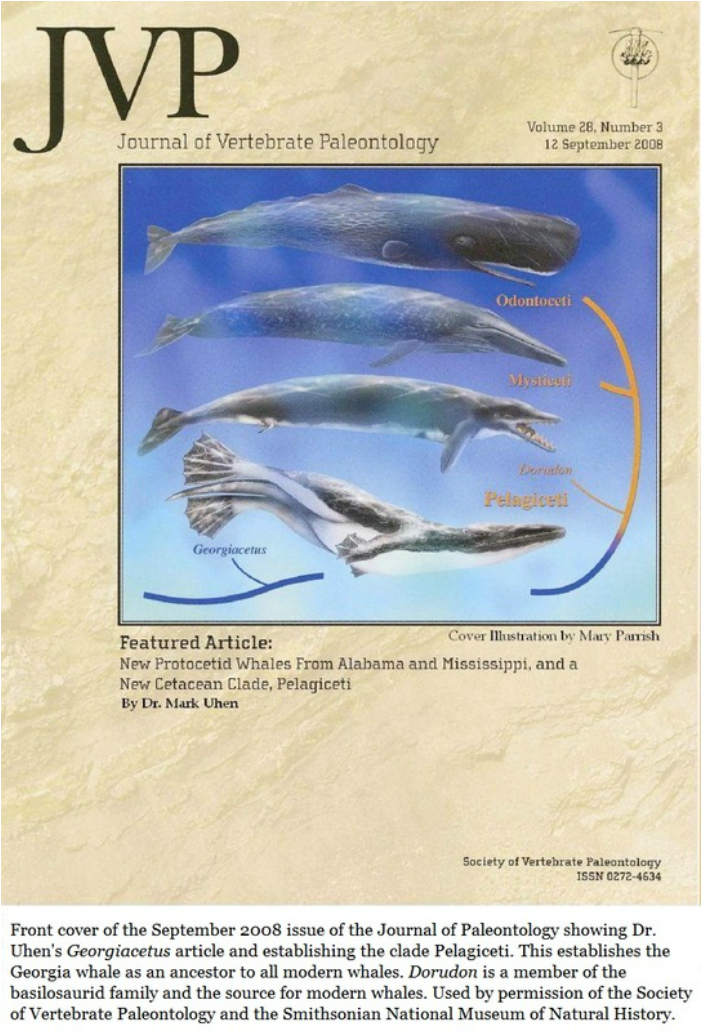
Georgiacetus was shown conclusively to lack a fluke in 2008 when Dr. Mark D. Uhen, who at the time was with the Smithsonian Institution’s National Museum of Natural History, published a paper over newly reported Georgiacetus fossils found in Alabama and Mississippi.
These included a partial jaw with three teeth, a beginning-of-tail vertebra and an end-of-tail vertebra. Interestingly; one of the teeth Uhen reported on possessed a large cavity, so we aren’t the only ones enduring tooth decay.
Both of the newly reported vertebrae were flanged. These flanges, or bony extensions, serve as anchoring points for muscles. The single end-of-tail vertebra Dr. Uhen reviewed was critical, it too was flanged. Flanged, end-of-tail vertebrae do not occur in modern whales with flukes.
These included a partial jaw with three teeth, a beginning-of-tail vertebra and an end-of-tail vertebra. Interestingly; one of the teeth Uhen reported on possessed a large cavity, so we aren’t the only ones enduring tooth decay.
Both of the newly reported vertebrae were flanged. These flanges, or bony extensions, serve as anchoring points for muscles. The single end-of-tail vertebra Dr. Uhen reviewed was critical, it too was flanged. Flanged, end-of-tail vertebrae do not occur in modern whales with flukes.
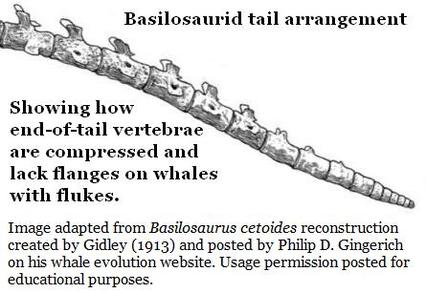
If a whale has flukes, the tail vertebrae are compressed, simplified and diminished, the fibrous tissue forming the fluke structure is anchored on these simplified vertebrae and the muscle is embedded within this fibrous tissue.
These new finds reported by Dr. Uhen showed that its tail vertebrae were not structured to support flukes. The apparent conclusion was that Georgiacetus lacked a fluke and swam with its hind legs.
The diverse basilosaurid family possesses the fluke supporting end-of-tail vertebrae structure seen in all modern whales and dolphins.
As we'll see modern whales probably diverged into the two modern lines (Suborders) of baleen and toothed through the basilosaurids.
These new finds reported by Dr. Uhen showed that its tail vertebrae were not structured to support flukes. The apparent conclusion was that Georgiacetus lacked a fluke and swam with its hind legs.
The diverse basilosaurid family possesses the fluke supporting end-of-tail vertebrae structure seen in all modern whales and dolphins.
As we'll see modern whales probably diverged into the two modern lines (Suborders) of baleen and toothed through the basilosaurids.
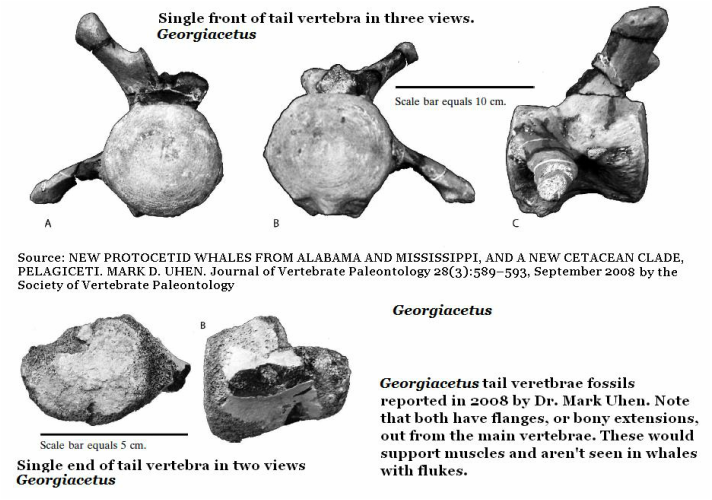
In this same paper Dr. Uhen also proposed the establishment of a new clade for whales named Pelagiceti, a “clade” being a single branch on the tree of life which establishes the relationships of species, linking extinct to modern species.
The clade Pelagiceti starts immediately after Georgiacetus, includes the basilosaurids, and extends all the way to the divergence of toothed and baleen whales and the Eocene/Oligocene transition.
This means that Georgiacetus vogtlensis is the best known candidate for the ancestor to all modern whales. The similarities between the genus Georgiacetus and the family Basilosauridae is remarkable.
Currently Dr. Uhen is a Professor of Vertebrate Paleontology at George Mason University in Fairfax, Virginia.
The clade Pelagiceti starts immediately after Georgiacetus, includes the basilosaurids, and extends all the way to the divergence of toothed and baleen whales and the Eocene/Oligocene transition.
This means that Georgiacetus vogtlensis is the best known candidate for the ancestor to all modern whales. The similarities between the genus Georgiacetus and the family Basilosauridae is remarkable.
Currently Dr. Uhen is a Professor of Vertebrate Paleontology at George Mason University in Fairfax, Virginia.
How does Georgiacetus show that evolution is random?
Dr. Katy Smith is Curator of Paleontology and Assistant Professor of Geology at Georgia Southern Museum. In April 2016 she presented a paper to the 65th annual meeting of the Geological Society of America.
Her presentation was entitled; Insights into the Locomotor Mode of the Ancient Whale Georgiacetus Based on Vertebral Morphology
gsa.confex.com/gsa/2016SE/webprogram/Paper273309.html
To quote the abstract:
Georgiacetus vogtlensis is one of the most primitive archaeocetes (ancient whales) from North America. Discovered in middle Eocene deposits of the northern Atlantic Coastal Plain of Georgia in 1983, it shows important adaptations toward fully aquatic behavior, including lack of articulation between the pelvis and sacral vertebrae.
It also exhibits characteristics similar to semi-aquatic mammals, including a sizable pelvis.
Georgiacetus, which is closely related to but not a member of the clade Pelagiceti (fully aquatic whales), is ideal for investigating skeletal changes associated with the land-to-sea transition evident in whale evolution.
Lumbar vertebrae underwent drastic changes during this transition, as dorsomobile whales evolved from dorsostable artiodactyls and locomotion via hindlimb propulsion (for semi-aquatic whales) was replaced by locomotion via vertebral undulation (for fully aquatic whales).
Thirteen measurements of vertebral morphology were collected from the two anterior-most (L1 and L2) and two posterior-most (LY and LZ) lumbar vertebrae of over 30 extant and extinct terrestrial, aquatic, and semi-aquatic mammals, including Georgiacetus.
Separate principal components analyses (PCA) were conducted for each vertebral position (L1, L2, LY, and LZ) using these measurements and specimens.
All four PCAs sorted specimens by vertebral mobility, and all four placed Georgiacetus between known dorsostable and known dorsomobile mammals. Separate discriminant function analyses (DFA) were also conducted for each vertebral position for fully and semi-aquatic specimens, using the same measurements and treating Georgiacetus as an unknown.
DFA of L1 and L2 categorized Georgiacetus as semi-aquatic, but DFA of LY and LZ characterized Georgiacetus as fully aquatic.
Because fully aquatic whales locomote via vertebral undulation, categorization of the posterior-most lumbar vertebrae of Georgiacetus as fully aquatic suggests an increasing reliance on vertebral undulation as its primary mode of locomotion, which in turn suggests a primarily aquatic lifestyle for this genus.
Dr. Smith is describing the vertebrae of a transitional whale. A mixture of attributes, in a single animal, suggesting a fully aquatic lifestyle adaptations (like a modern whale) and amphibious adaptations (like a modern seal). Georgiacetus possesses both types of vertebrae in a single vertebra column.
These features indicate a transition from amphibious ancestors to a fully marine life. They are not seen in previous species. They are amplified in later species.
Clearly the features were successful for Georgiacetus as multiple individuals occur at the Plant Vogtle site and additional individuals are known from Alabama, Mississippi & possibly Texas.
When the species emerged, (perhaps as a Hopeful Monster? en.wikipedia.org/wiki/Saltation_(biology)) these random adaptations, or mutations, would have made it different than it's peers. They proved successful so they were reinforced in later generations.
Bear in mind that our own genus, Homo, emerged more than 37 million years after Georgiacetus lived.
Dr. Katy Smith is Curator of Paleontology and Assistant Professor of Geology at Georgia Southern Museum. In April 2016 she presented a paper to the 65th annual meeting of the Geological Society of America.
Her presentation was entitled; Insights into the Locomotor Mode of the Ancient Whale Georgiacetus Based on Vertebral Morphology
gsa.confex.com/gsa/2016SE/webprogram/Paper273309.html
To quote the abstract:
Georgiacetus vogtlensis is one of the most primitive archaeocetes (ancient whales) from North America. Discovered in middle Eocene deposits of the northern Atlantic Coastal Plain of Georgia in 1983, it shows important adaptations toward fully aquatic behavior, including lack of articulation between the pelvis and sacral vertebrae.
It also exhibits characteristics similar to semi-aquatic mammals, including a sizable pelvis.
Georgiacetus, which is closely related to but not a member of the clade Pelagiceti (fully aquatic whales), is ideal for investigating skeletal changes associated with the land-to-sea transition evident in whale evolution.
Lumbar vertebrae underwent drastic changes during this transition, as dorsomobile whales evolved from dorsostable artiodactyls and locomotion via hindlimb propulsion (for semi-aquatic whales) was replaced by locomotion via vertebral undulation (for fully aquatic whales).
Thirteen measurements of vertebral morphology were collected from the two anterior-most (L1 and L2) and two posterior-most (LY and LZ) lumbar vertebrae of over 30 extant and extinct terrestrial, aquatic, and semi-aquatic mammals, including Georgiacetus.
Separate principal components analyses (PCA) were conducted for each vertebral position (L1, L2, LY, and LZ) using these measurements and specimens.
All four PCAs sorted specimens by vertebral mobility, and all four placed Georgiacetus between known dorsostable and known dorsomobile mammals. Separate discriminant function analyses (DFA) were also conducted for each vertebral position for fully and semi-aquatic specimens, using the same measurements and treating Georgiacetus as an unknown.
DFA of L1 and L2 categorized Georgiacetus as semi-aquatic, but DFA of LY and LZ characterized Georgiacetus as fully aquatic.
Because fully aquatic whales locomote via vertebral undulation, categorization of the posterior-most lumbar vertebrae of Georgiacetus as fully aquatic suggests an increasing reliance on vertebral undulation as its primary mode of locomotion, which in turn suggests a primarily aquatic lifestyle for this genus.
Dr. Smith is describing the vertebrae of a transitional whale. A mixture of attributes, in a single animal, suggesting a fully aquatic lifestyle adaptations (like a modern whale) and amphibious adaptations (like a modern seal). Georgiacetus possesses both types of vertebrae in a single vertebra column.
These features indicate a transition from amphibious ancestors to a fully marine life. They are not seen in previous species. They are amplified in later species.
Clearly the features were successful for Georgiacetus as multiple individuals occur at the Plant Vogtle site and additional individuals are known from Alabama, Mississippi & possibly Texas.
When the species emerged, (perhaps as a Hopeful Monster? en.wikipedia.org/wiki/Saltation_(biology)) these random adaptations, or mutations, would have made it different than it's peers. They proved successful so they were reinforced in later generations.
Bear in mind that our own genus, Homo, emerged more than 37 million years after Georgiacetus lived.
Global Perspective
Globally, the dinosaurs were long gone, mammals had diversified wildly and were approaching ascendency. Even toed and odd toed hoofed animals, the ungulates, quickly radiated and diversified. Hooved predators were widespread.
Large mammals appear due to a large increase in atmospheric oxygen. Large mammals require oxygen dense air to support themselves; especially pregnant females.
The stage is set for large whales and they will soon occur, though we’re still a long way away from modern whales.
These original images of Georgiacetus were created in 2011 by Xavier Sims at Georgia Southwestern State University in Americus. They have been reviewed by Dr. Mark Uhen. I am grateful to Xavier for this superb work which had to be redone several times as Dr. Uhen and I exchanged emails trying to provide Xavier with accurate information.
I want to thank Mary Parrish, Department of Paleobiology Illustrator for the Smithsonian Institute’s National Museum of Natural History in Washington. She had provided the illustrations of Georgiacetus for Dr. Uhen’s 2008 Georgiacetus paper entitled; New Protocetid Whales from Alabama and Mississippi, and a New Cetacean Clade, Pelagiceti; which was published by and made the cover of the 12/September/2008 issue of the prestigious Journal of Vertebrate Paleontology (Vol.8 No.3) from the Society of Vertebrate Paleontology. (Congrats to Dr. Uhen for the cover story and Mary Parrish for the cover art.)
Globally, the dinosaurs were long gone, mammals had diversified wildly and were approaching ascendency. Even toed and odd toed hoofed animals, the ungulates, quickly radiated and diversified. Hooved predators were widespread.
Large mammals appear due to a large increase in atmospheric oxygen. Large mammals require oxygen dense air to support themselves; especially pregnant females.
The stage is set for large whales and they will soon occur, though we’re still a long way away from modern whales.
These original images of Georgiacetus were created in 2011 by Xavier Sims at Georgia Southwestern State University in Americus. They have been reviewed by Dr. Mark Uhen. I am grateful to Xavier for this superb work which had to be redone several times as Dr. Uhen and I exchanged emails trying to provide Xavier with accurate information.
I want to thank Mary Parrish, Department of Paleobiology Illustrator for the Smithsonian Institute’s National Museum of Natural History in Washington. She had provided the illustrations of Georgiacetus for Dr. Uhen’s 2008 Georgiacetus paper entitled; New Protocetid Whales from Alabama and Mississippi, and a New Cetacean Clade, Pelagiceti; which was published by and made the cover of the 12/September/2008 issue of the prestigious Journal of Vertebrate Paleontology (Vol.8 No.3) from the Society of Vertebrate Paleontology. (Congrats to Dr. Uhen for the cover story and Mary Parrish for the cover art.)
References:
Georgiacetus vogtlensis
A New Middle Eocene Protocetid Whale (Mammalia: Cetacea: Archeoceti) and associated Biota From Georgia. Richard C. Hulbert, Jr. Richard M. Petkewich, Gale A. Bishop, David Bukry and David P. Aleshire. Journal of Paleontology, Vol.72, No.5, 1998. The Paleontological Society
Legs as a means of propulsion:
New Protocetid Whales from Alabama and Mississippi, and a New Cetacean Clade, Pelagiceti. Mark D. Uhen. Journal of Vertebrate Paleontology. Vol. 28, No.3, September 2008, Society of Vertebrate Paleontology.
New Observations on Eocene Strata & Microfossils at Plant Vogtle, Burke County Eastern Georgia; WILLOUGHBY, Ralph H.1, DOCKERY, David T. III2, GLIDDEN, Timothy C.3, and SYMS, Frank H.3, (1) 195 Our Road, Salley, SC 29137, (2) Mississippi Office of Geology, Mississippi Department of Enviromental Quality, P.O. Box 2279, Jackson, MS 39225-2279, (3) Fugro William Lettis, 1454 Green Street, Suite A, Augusta, GA 30910. Presented at the Geological Society of America Southeastern Section 60th annual meeting March 2011
Insights into the Locomotor Mode of the Ancient Whale Georgiacetus Based on Vertebral Morphology: Smith, Kathlyn M., Department of Geology and Geography, Georgia Southern University, Box 8149, Statesboro, GA 30460, LEVERETT, Kelsi Tate, Department of Geosciences and Geological and Petroleum Engineering, Missouri University of Science and Technology, 129 McNutt Hall, 1400 North Bishop, Rolla, MO 65409 and BEBEJ, Ryan M., Department of Biology, Calvin College, 1726 Knollcrest Circle SE, Grand Rapids, MI 49546. Presentation at the 65th annual meeting of the Geological Society of America, 1/April/2016, Southeastern Section, Fossil Vertebrates of the Southeastern United States.
Georgiacetus vogtlensis
A New Middle Eocene Protocetid Whale (Mammalia: Cetacea: Archeoceti) and associated Biota From Georgia. Richard C. Hulbert, Jr. Richard M. Petkewich, Gale A. Bishop, David Bukry and David P. Aleshire. Journal of Paleontology, Vol.72, No.5, 1998. The Paleontological Society
Legs as a means of propulsion:
New Protocetid Whales from Alabama and Mississippi, and a New Cetacean Clade, Pelagiceti. Mark D. Uhen. Journal of Vertebrate Paleontology. Vol. 28, No.3, September 2008, Society of Vertebrate Paleontology.
New Observations on Eocene Strata & Microfossils at Plant Vogtle, Burke County Eastern Georgia; WILLOUGHBY, Ralph H.1, DOCKERY, David T. III2, GLIDDEN, Timothy C.3, and SYMS, Frank H.3, (1) 195 Our Road, Salley, SC 29137, (2) Mississippi Office of Geology, Mississippi Department of Enviromental Quality, P.O. Box 2279, Jackson, MS 39225-2279, (3) Fugro William Lettis, 1454 Green Street, Suite A, Augusta, GA 30910. Presented at the Geological Society of America Southeastern Section 60th annual meeting March 2011
Insights into the Locomotor Mode of the Ancient Whale Georgiacetus Based on Vertebral Morphology: Smith, Kathlyn M., Department of Geology and Geography, Georgia Southern University, Box 8149, Statesboro, GA 30460, LEVERETT, Kelsi Tate, Department of Geosciences and Geological and Petroleum Engineering, Missouri University of Science and Technology, 129 McNutt Hall, 1400 North Bishop, Rolla, MO 65409 and BEBEJ, Ryan M., Department of Biology, Calvin College, 1726 Knollcrest Circle SE, Grand Rapids, MI 49546. Presentation at the 65th annual meeting of the Geological Society of America, 1/April/2016, Southeastern Section, Fossil Vertebrates of the Southeastern United States.
